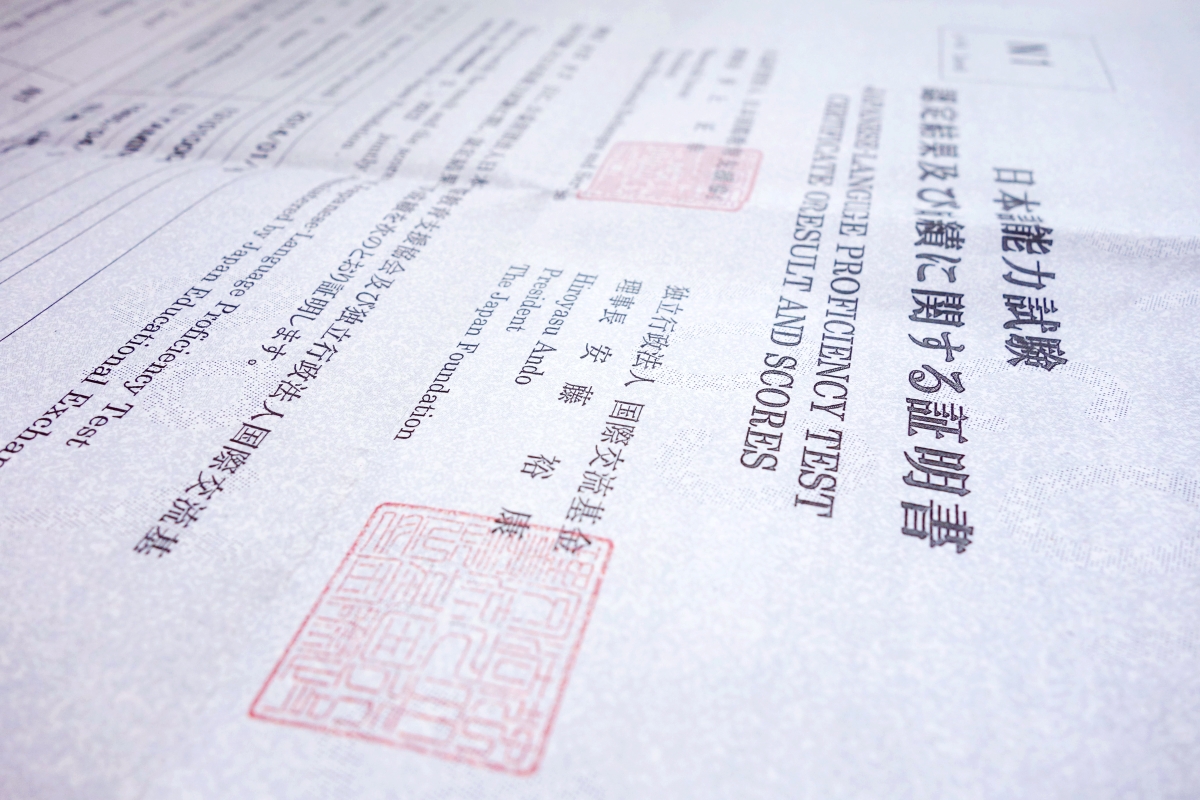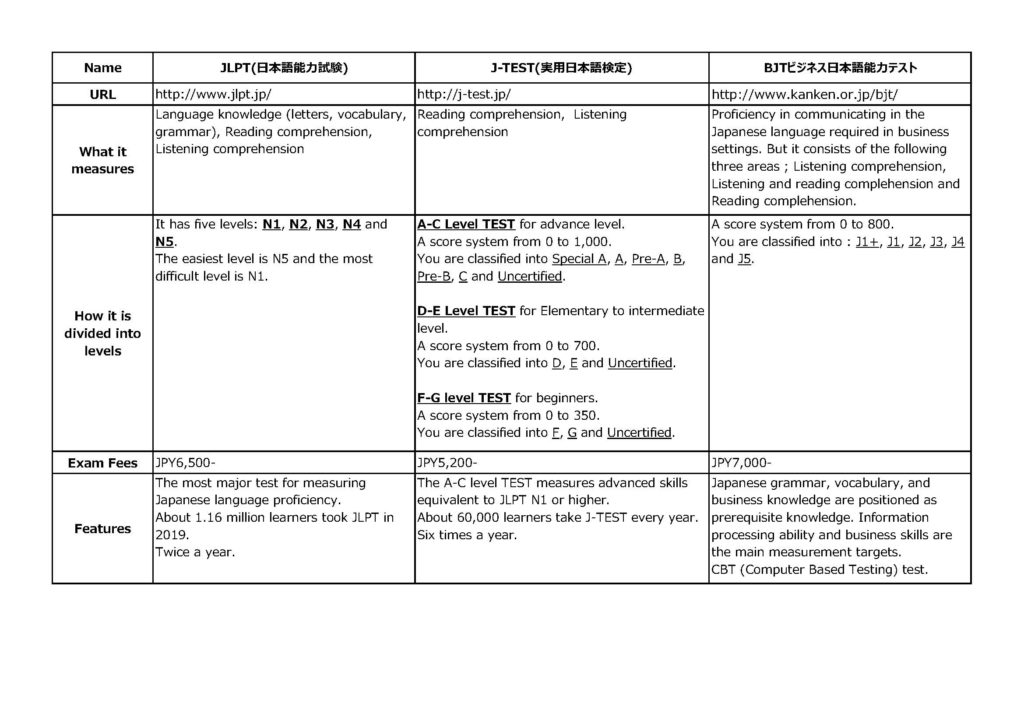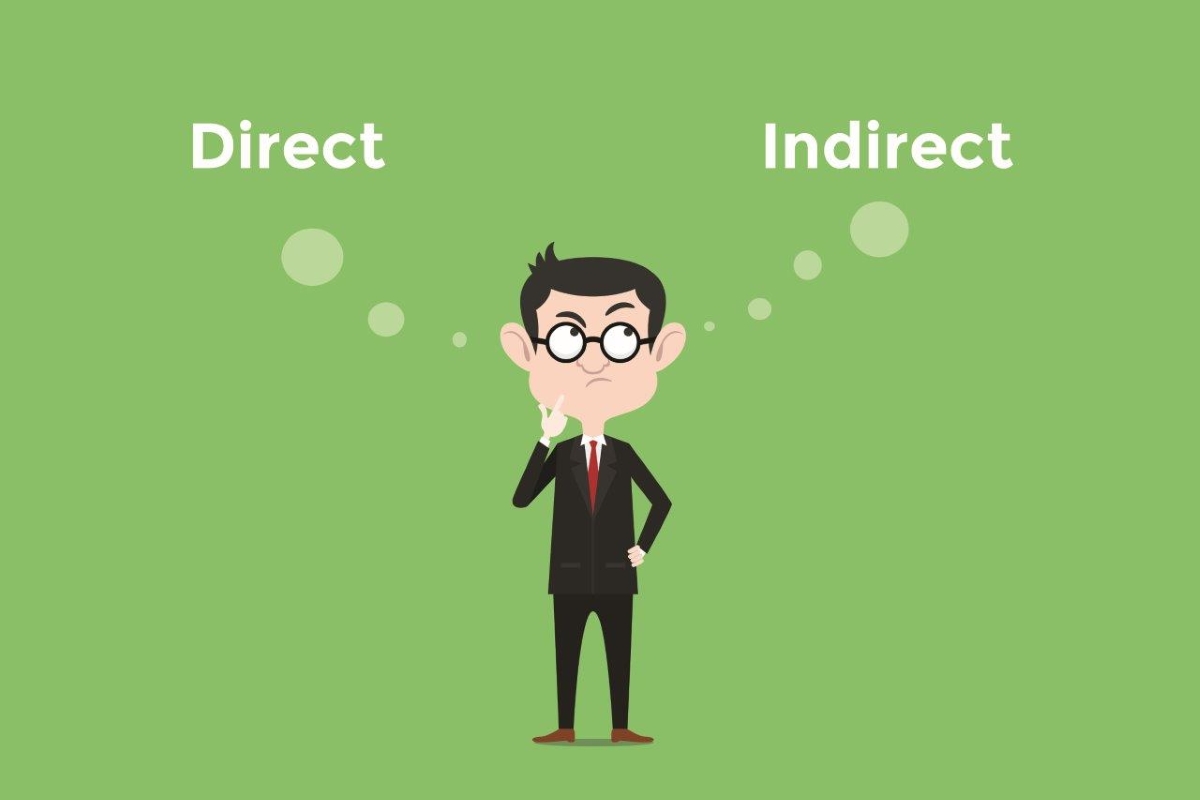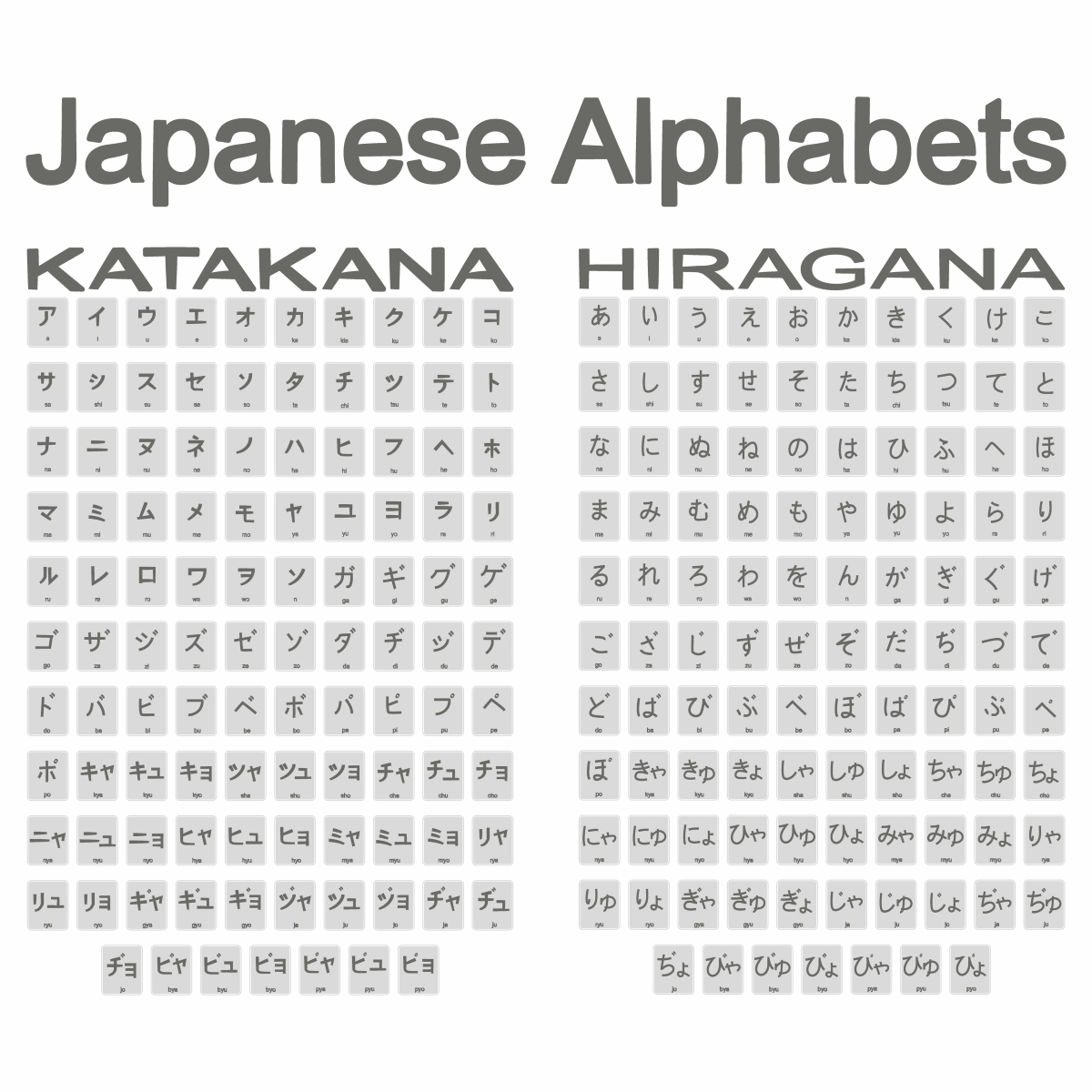Should I take the JLPT?
February 17, 2022
This is a question that has some divided opinions among Japanese language teachers.
If you are an international student, it may be required for university admission, but if you are a businessperson, it is probably not. Studying for the JLPT can be useful, so in this article, we have organized the features of the JLPT, so that you can decide for yourself whether it is worth taking or not.

Feature (1): Listening and reading test
There is no writing and speaking. In other words, you will not know how well you can actually communicate in Japanese.
Even if a person has passed N1, which is the highest level, there are still people who might not even be able to carry on daily conversations.
Feature (2): The most famous test to measure Japanese language proficiency
As mentioned above, the JLPT does not measure the actual operational ability, but it is the most popular and well-known test, so many companies use the JLPT as an indicator for hiring requirements.
Feature (3): Easy to prepare for and easy to study on your own.
As mentioned in (1), the JLPT is an input-based test, so the skills to be developed are clear and easy to prepare for. Also, as mentioned in (2), since many people take it, there are many materials available for it. Therefore, it is possible to reach a certain level by just self-study.
For example, if you improve your basic vocabulary and grammar by studying for the JLPT on your own, and then take lessons after you have reached a certain level, you will be able to reduce the total cost of studying Japanese.
Feature (4) You can get points to receive preferential treatment in Japan’s immigration control.
Those who pass JLPT N1 receive 15 points, N2 receive 10 points under the government’s “Point-based Preferential Immigration Treatment System for Highly Skilled Foreign Professionals.” Individuals with a total of 70 points or higher receive preferential treatment at immigration. For BJT, 15 points will be awarded for 480 points or above, and 10 points will be awarded for 400 points or above.
For more information, please visit the Immigration Bureau of the Ministry of Justice website.
https://www.moj.go.jp/isa/other_languages.html
Based on the four points above, if you feel that there is an overall benefit, why not give it a try? You should also consider whether or not you can realistically invest the amount of time required to pass the test.
Please refer to this article for the study time required to pass the JLPT.
What kind of tests are there for Japanese language?
February 17, 2022
The most famous test is the JLPT (Japanese Language Proficiency Test), but many people also take the J-TEST, BJT, and others. So here is a summary of them including what it measures, how it is divided into levels, the cost, and the features.

Please check the official website for details and the latest information.
JLPT(Japanese Language Proficiency Test) http://www.jlpt.jp/
J-TEST (Practical Japanese Language Test) http://j-test.jp/
BJT (Business Japanese Proficiency Test) http://www.kanken.or.jp/bjt/
Do you have any tips for staying motivated?
February 4, 2022

Yes, there are some. But first, I suggest you understand the characteristics of motivation.
-Motivation is not constant, it always changes.
-When you encounter difficulties, your motivation is more likely to go down than up.
In light of the above, my advice is not to think of ways to maintain your motivation, but rather to think of ways to continue learning Japanese even when your motivation drops.
Specifically, I recommend the following methods.
(1) Make Japanese study a habit.
You don’t need to be motivated when you brush your teeth. This is because it has become a daily activity for you. Make it a habit to study every day, even for a short time.
(2) Declare your goals to the people around you.
People are less likely to slack off when they feel like they are being watched, so declare your goals to your family and friends, and if you do on SNS, you may find others with similar goals. For this reason, it is important to make your study plan achievable.
(For more information on how to create a study plan, please refer to this article.)
(3) Always think positively.
As you continue to study, there may come a time when you want to quit. For example, even though you are studying hard, you may not be able to improve. In such cases, believe that you can definitely grow because you are studying efficiently, and continue steadily.
These methods can be used for more than just learning Japanese, so I hope they will help you in your other challenges as well. I have been successful in dieting and TOEIC by using the above methods. And now I’ve declared my goal to finish a full marathon within 4 hours!
Do you have any tips for creating a Japanese study plan?
February 2, 2022
The key to creating a plan is “SMART”. The word “SMART” comes from coaching and is a combination of the following five acronyms

(1) S: Specific
The more specific and clear your goals are, the more vividly you can imagine the process of achieving them.
(2) M: Measurable
When you set a numerical goal, you will know whether the goal has been achieved or not. On the other hand, if you set a goal that you cannot determine whether it has been achieved or not, you will not be able to use the PDCA cycle when thinking about the next goal.
(3) A: Achievable
Do not create a plan that is too difficult. Consider the difference between your current level and your target level, and make your plan realistic.
(4) R: Relevant
Create long-term, medium-term, and short-term goals respectively, and link the three together.
(5) T: Time-bound
Stop being vague and say, “Someday”, “sometime soon” and set a clear deadline. By setting a deadline, your plan will become more concrete and realistic.
Based on these five points, set long-term, medium-term, and short-term goals that suit you.
Please refer to the following examples.
Example 1
Long-term goal: Pass JLPT N1 in December 20XX.
Mid-term goal: Pass JLPT N2 one year before that, and N3 two years before that.
Short term goal: Memorize 500 Kanji characters by~, 1000 by~ and 1500 by~. Memorize 500 vocabs by~, 1000 by~ and 1,500 by~.
Study for one hour every day.
Example 2
Long-term goal: To be able to give a 5-minute speech in Japanese by the conference in XX/XX/XXXX.
Mid-term goal: To be able to hold a simple conversation by XX, 20XX, and to be able to hold a daily conversation by XX, 20XX.
Short term goal: To finish the ~ textbook by~ and the next textbook by~.
Take two lessons and do four hours of self-study every week.
As for (3) A: Achievable, it is recommended that you have your Japanese teacher or someone with experience in learning Japanese check it out if possible.
Should I make a plan to study Japanese?
February 2, 2022

If you want to increase your chances of success as much as possible, I recommend that you create a study plan.
Learning a language is often compared to “sailing,” “mountain climbing,” or “running a marathon,” all of which have a clear goal and a plan to reach it. Learning a language is a longer term game than those, so I think it’s better to create one.
The specific advantage of creating a study plan is that it will increase your chances of entering the following spiral.
If you create an appropriate study plan, it will be easier to continue studying.
If you can keep studying, it will be easier to grow.
If you grow, studying becomes fun.
If it becomes fun, it becomes easier to continue studying.
However, some people are not very good at making plans or studying step by step.

There are two types of learners: the climber type and the surfer type. The climber type is the one who is good at following a plan step by step, while the surfer type is the one who wants to study while having fun(*).

For the surfer type, it is more fun to watch Japanese movies and dramas or talk with Japanese people than to follow a plan and study step by step. And if they don’t enjoy it, they won’t be motivated and are more likely to stop studying. Studying is meaningless if you don’t continue, so it is important to choose a learning method that makes it easy for you to continue studying.
*Please forgive me if I use this analogy for convenience. I do surf as a hobby, but my learning style is climber type, so I understand that this analogy is not appropriate for some people.

First, let’s think about what exactly is needed to be a good conversationalist of Japanese.
(1) Accurately understand the Japanese that the other person speaks.
(2) Answer in appropriate Japanese.
(3) Develop the conversation.
(4) Make the person think, “I want to talk to you again.
(1) and (2) are mainly Japanese language skills, and (3) and (4) are mainly communication skills. In other words, becoming a good conversationalist is a highly challenging mission that requires both comprehensive Japanese language skills and communication skills.
Next, let’s consider how to deal with each of these items.
For (1) and (2), you can “strengthen your listening skills,” “increase the number of sentence patterns you can use,” and “strengthen your pronunciation. I think you have already tried various study methods for them, but it takes time before you see results. Therefore, I would like to share with you the tips for (3) and (4), which are relatively quick to produce results.
Imagine that you are asked by Tanaka-san, “Do you like Japanese food? Then look at the following four responses.
A: Yes, I like it.
B: Yes, I like it. I like sushi.
C: Yes, I like it. I like sushi and I want to catch a tuna someday.
D: Yes, I like it. I like sushi and I want to catch a tuna someday. Where can I go in Japan to catch tuna?
You can see that the conversation is developing in the order of A<B<C<D. In order to develop a conversation, it is effective to "dig into the topic," "broaden the topic," and "ask the other person questions.
In the case of above “D”, if Tanaka-san is interested in fishing, you can move on to the topic of fishing and get the conversation going. (This is an example of digging into the topic.) If Tanaka-san is not interested in fishing, you can ask about his/her hobbies and how he/she spends his/her days off. (This is an example of broadening the topic.)
In addition, if you try to be cheerful, fun, positive, and provide useful and informative information to the other person as much as possible, you will increase the probability that he or she will want to talk to you again.
I think, even in your native language, some are fun to talk but others are not. And I am sure that the former people have these characteristics.
My advice to you is to improve both your Japanese language skills and your communication skills.

First, let me explain the difference between the direct method and the indirect method in learning Japanese.
The direct method means that the explanation is given in Japanese only.
The indirect method is to receive an explanation using a mediating language that the learner can understand (in most cases, the learner’s mother tongue).
If your native language is English, you may worry about whether it’s better to temporarily get explanations in English or to get explanations in Japanese. In the end, it depends on your preferences, but let’s consider the pros and cons of both methods.
Direct Method – Pros
-Learners will develop a habit of reasoning based on words they do know even if there are words they do not understand.
-Lessons can be taken in a form that closely resembles an actual conversation in Japanese.
Direct Method – Cons
-Learners will sometimes misunderstand.
-It may take a while before the learner can understand.
Indirect Method – Pros
-Explanations are definitely easier to understand.
-Learners can understand in a short amount of time.
Indirect Method – Cons
-It’s easy for learners to develop a habit of always thinking in their native language.
-It’s hard for learners to develop a habit of reasoning based on the Japanese they know.
-There may be many instances of not understanding when having an actual conversation in Japanese.
The indirect method is less stressful because beginners cannot understand explanations in Japanese. However, the advantage of studying using the direct method from the beginning is that learners are better prepared for a real conversation because they have been listening to actually conversations in Japanese only. In other words, the difference is whether you consider speaking only in Japanese as “stressful” or “good training.”
I recommend the following approach for people who want to become used to Japanese as quickly as possible, but who also want to use their lesson time efficiently.
・First, tell your instructor ahead of time not to use an intermediate language unless you request otherwise, and basically use Japanese only.
・Then, ask your instructor for explanations in an intermediate language only when you can’t understand no matter how hard you try.
However, make an agreement with your instructor not to use an intermediate language more than three times per lesson.
(It doesn’t matter if you agree to five times or ten times, it’s just seems best to use an intermediate language as little as possible.)
・Then, do not use an intermediate language more than the agreed number of times no matter how frustrating it becomes.
I recommend this approach because, by sticking to these rules, you will develop a habit of thinking for yourself as much as possible even when you don’t understand and you can enjoy your lessons like a game.
Should I learn Kanji characters? How many kanji do I need to learn?
February 1, 2022
If you are working in Japan, living in Japan, or aiming for an intermediate level or higher, the answer is yes.
The target number depends on your learning objectives. For example, if you want to be able to live comfortably in daily life in Japan, you should aim for about 1000 characters.
If you want to understand newspapers, books, magazines, Manga, etc., please refer to the following table.
—————————–
Number of kanji learned : How much you can understand (supplementary information)
—————————–
(1)100 characters : approx. 30% (Can read only some plain kanji. It is difficult to grasp the meaning of the whole text.)
(2)300 characters : approx. 50% (Begins to get used to kanji and can guess the meaning of difficult kanji.
(3)500 characters : approx. 70% (Can understand almost all the kanji that appear in the manga)
(4)1000 characters : approx. 90% (Can understand most of the kanji found in daily life)
(5)2000 characters : approx. 95% (Knowledge equivalent to that of an average Japanese working adult. Can live in a Japanese only environment without any difficulty)
If you take the JLPT, you will usually need the following number of kanji and study time.
—————————–
Level : Number of Kanji to learn (approximate number of study hours required to pass)
—————————–
N5 : 100 characters (150 hours)
N4 : 300 characters (300 hours)
N3 : 600 characters (450 hours)
N2 : 1000 characters (600 hours)
N1 : 2000 characters (900 hours)

Should I learn Hiragana and Katakana first?
February 1, 2022
I recommend to learn Hiragana and Katakana from an early stage, if you don’t have any special reasons.
Perhaps you know that once you learn touch typing your PC work efficiency quickly improves afterwards. Learning Hiragana and Katakana has the same benefit. Although it takes a little time in the beginning, when one considers the resulting increase in learning efficiency later, it’s best to learn them at an early stage.

Is it possible to master Japanese just by studying on my own?
February 1, 2022

If I had to choose between “there is a possibility” and “there is no possibility”, I would say “there is a possibility”. In fact, there are some people who have mastered it just by self-study. However, for many people, the learning effect is poor and the risk of failure is high, for the following reasons.
-Because of the lack of feedback, they are unaware of misuse.
-Inability to choose the best learning method and plan.
-It is difficult to maintain motivation.
The main reason for wanting to learn on your own is probably cost. If you want to keep the cost as low as possible, I recommend that you do as much as you can on your own, and then take lessons to learn only what you need to learn from a teacher.
What you can do on your own is mainly input type practice, such as learning vocabulary and basic sentence structure, listening practice, reading practice, etc. On the other hand, what you should practice with a teacher is mainly output type practice, such as pronunciation practice, conversation practice, writing practice, etc.
Categories
Recent Posts
- I cannot keep up with meetings conducted in Japanese. Are there any good ways to study?
- Are there any good writing materials for business Japanese? (Three keys to developing business Japanese writing skills.)
- Are there any free materials available for studying business Japanese reading?
- Should I read newspapers for reading practice in business Japanese?
- Are there any good business magazines to practice reading business Japanese?
Archives
- August 2022
- June 2022
- May 2022
- April 2022
- March 2022
- February 2022
- January 2022
- October 2021
- January 2021
- August 2020
- July 2020
- June 2020
- May 2020
- April 2020
- March 2020
- February 2020
- January 2020
- December 2019
- November 2019
- October 2019
- September 2019
- August 2019
- July 2019
- June 2019
- May 2019
- April 2019
- March 2019
- February 2019
- January 2019
- December 2018
- November 2018
- October 2018
- September 2018
- August 2018
- July 2018
- June 2018
- May 2018
- April 2018
- March 2018
- February 2018
- January 2018
- November 2017
- October 2017
- July 2017
